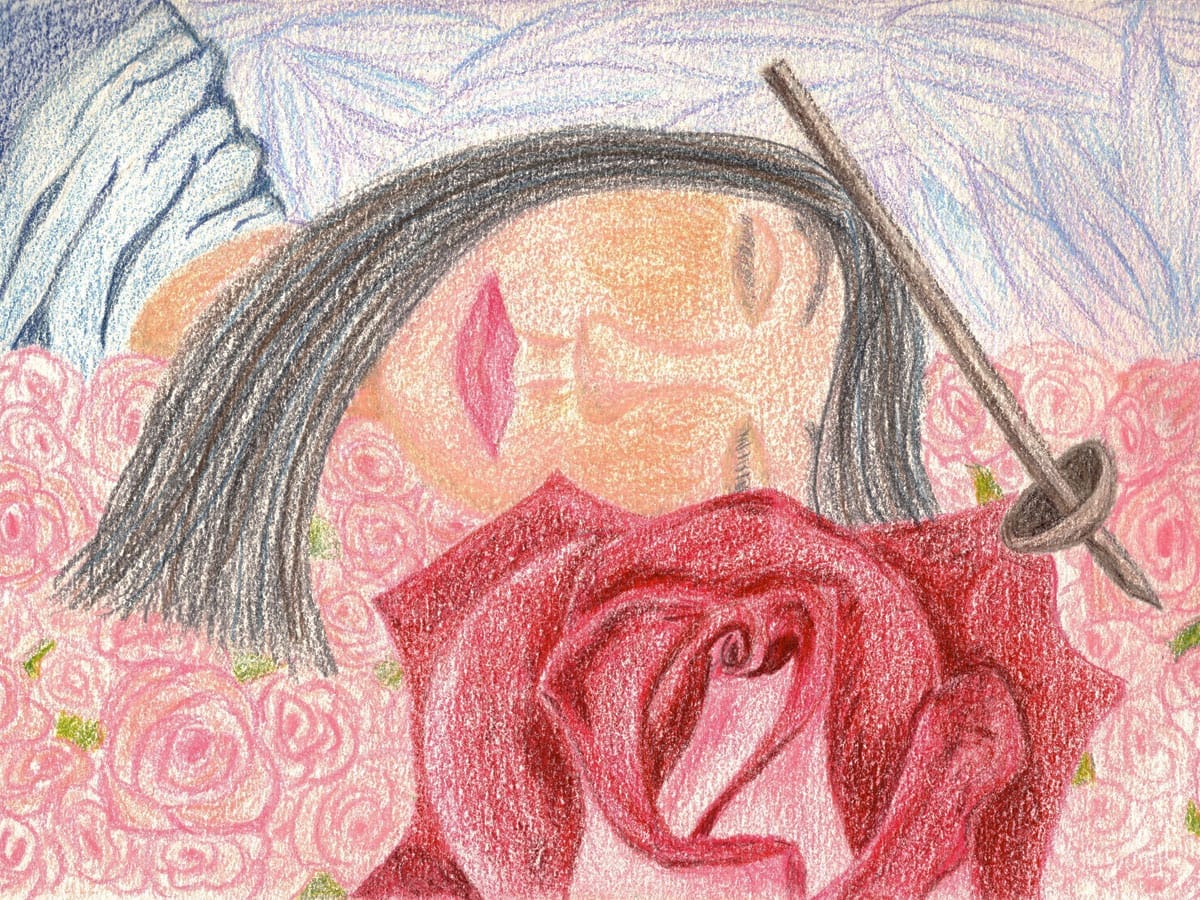Cycles of Creativity: Little Brier Rose
Little Brier Rose – Cycles of Creativity
Link to the story of Little Brier Rose and others of this tale type: https://sites.pitt.edu/~dash/type0410.html
Meaning of the Spindle
The spindle is a symbol of lengthy and monotonous hard work.
A recurring symbol in European folktales, the spindle is long rod with a pointed end and made of wood or metal. A ball of wool (or flax) is spun into yarn around the spindle by hand. This is simple technology, but ridiculously time and energy consuming. It is easiest to understand by watching. Here is a good demonstration: https://youtu.be/mzoJidU1d-8?t=215
In fairy tales, old women appear with giant hands overworked from decades of spinning. A spinster is a woman who has worked her way through life and hasn’t been provided for through marriage.
The spindle and spinster are metaphors for valuing oneself only through one’s work.
The spindle literally spins in place. The curse is that the work is endless. You’re just spinning in circles. The spindle also represents spinning off in your mind, never getting anywhere with your creative ideas.
The Avoidant Artist
Little Brier Rose falls asleep as a result of the spindle’s tip piercing her. Like her, we can fall into inaction when contacting a tool of creativity (the spindle). We freeze, not knowing what to do with our creativity. We fear criticism and failure, so we put our inner artist to sleep. This tale shows that protecting our ideas from the outside world in a hedge of thorns renders them useless.
We believe we can’t create, we won’t know what to do, so we don’t even start. This is the tale of the avoidant artist archetype, the artist’s shadow.
The story of Little Brier Rose can be the story of the woman who spins ideas ceaselessly but never manifests them. She is the aspect of ourselves that refuses to bring our creativity into the world.
Instead we resort to spinning creative ideas in our head in a hidden room. We don’t make anything of our creative potential. In this case, the “sleep” is an isolation, a tucking away, of our creativity. When someone says, “I don’t have a creative bone in my body,” they are under the sleeping spell of Little Brier Rose.
We need to experience the curse of Little Brier Rose to understand the dangers of stifling the creative life.
The Trance of Work
When pricked by the pointed spindle, we can see Little Brier Rose as being “bitten” by the work bug. This is an intoxication by the drive to achieve and succeed. This is the trance of productivity that never ends, the curse of the adult life. When we come of age, cultural conditioning tells us that we need to monetize our talent and make a living. Our creativity needs to be marketable.
Little Brier Rose is not made awake to the world, but put asleep to it. In the same way, we “grow up”, fall into the daily grind, and become numb to who we are. We become unconscious and lose access to our authentic selves and our creativity. At just the moment when Little Brier Rose should be going out to experience the world, she’s drawn inward. Right when she is becoming a woman, her fertility is locked in.
The experience of being cursed into the trance of productivity produces a deep wound, a sense of unfairness. This is both the prick of the spindle and the digging in of the thorns, but we’ll talk more about those in a moment.
This is the story of the woman who puts her creative dreams for herself to sleep in exchange for the endless work of caring for her family and/or friends. It can also be the story of the career woman, who puts her playful, creative self to sleep so she can engage in the endless game of climbing the corporate ladder and amassing prestige and wealth.
Sleep as a Death
Sleep can be about going unconscious, becoming complacent. Despite the warning that the curse will happen and making every effort to prevent it, the curse is inevitable. The parents forget the danger and leave Little Brier Rose alone on her birthday.
The same happens to us when our own worlds and preoccupations entrance us. We forget our inner life. We become unconscious to unhealthy patterns that run us. Our shadow gets ahold of us.
In fairy tales, sleep symbolizes death. Most often, sleep is a metaphor for the death of innocence. The harshness and evil in the world (like Snow White and the witch with the poisoned apple) confronts the child and she dies to her naive, carefree nature. In addition to the death of innocence, we see the death of the ego self. Little Brier Rose’s story reflects all of the ways we die to ourselves.
Gift of the Deep Sleep
The curse of unconsciousness is a curse of stagnation that happens many times in our life. This when we feel stuck.
The ego may think it’s time to go out into the world, but the soul knows otherwise. Little Brier Rose gives in to the urge to wander the castle, which stands for her interior. She opens doors in a tower she’s never been to. This desire is a soulful one, drawing us into our mysterious inner landscape.
Joseph Campbell speaks about Little Brier Rose’s sleep as a refusal of the call to adventure. From the perspective of the avoidant artist this is true. However, her sleep is also answering a call – the call to soulfulness.
Little Brier Rose’s sleep may look like a curse, but it holds great gifts for the soul. Sleep is her initiation into the unconscious and a deep dive into the unknown. I always wonder, “What did she dream during that time?”
For us, a time of being stuck or spinning one’s wheels may feel like a curse, but it is actually a part of the soul’s natural cycle. Rather than be angry about your inability to get your life in gear, consider the following gifts of sleep.
Sleep is a metaphor for gestation. In the dreamtime, our psyche evolves by working out issues in the subconscious. Like a baby in the womb, our creative ideas need time to develop in darkness and silence. The self needs to form her identity away from the world, uncorrupted by outside opinions. The same is true of our creativity and our creative projects.
Watch Stacey’s discussion with Naven Lizon about the story of Little Brier Rose and how fairytales can guide us to soul wisdom:
Waiting for Right Timing
Sleep is a metaphor for hibernation in winter and the dormancy of the seed.
We see this in a variation of Little Brier Rose from France called “Sun, Pearl and Anna” from author Giuseppe Pitre. To shelter her from the curse, the girl, Anna, is raised in an underground house. Anna is the seed under dark soil. When she falls into a deep sleep, her father seals her in a beautiful coffin in a locked cottage in the woods. We see here that layers of sleep and dormancy can occur too, one right after the next. Sometimes it takes a long while to wake up. Multiple layers of protective insulation help growth to occur – wilderness, cabin, coffin, and sleep.
Waiting can bring the frustrating feeling that we’re biding or wasting our time.
On the other hand, waiting can a state of availability and openness to what might come at the right time. There is something about sharing a project with the world that involves right timing. How many times have you tried to get a new idea off the ground only to find that it wasn’t the right time? The dormant seed waits for the ideal moment to sprout.
Valuing Rest
Nature knows that stillness must happen before emergence. Our souls and creativity need time for rest and latency. Things need to soak and recharge. We need to oscillate between sleep and wakefulness. It’s unhealthy to be alert and busy all the time.
Our cycles of sleep can literally be times of lassitude, laying around on the couch getting nothing done. Our sleep can also take the form of non-doing. The practice of being, such as meditation and contemplation, serve the soul with rest. We may literally need to isolate ourselves from the world by going on retreat or, at least, turning off our phones. Embracing the natural call of the soul to sleep allows for creative engagement with it.
Hedge of Thorns
The hedge of thorns represents the ways we protect ourselves when resting and incubating a new idea. However, the thorny hedge can also be an unhealthy defense mechanism. Seen as a shadow aspect, the hedge is a symbol of the ways we protect our heart and won’t let anyone in.
Thorns are a symbol of pain and shame, the belief in our own sinfulness. Jesus’s crown of thorns was a tool of humiliation. We speak of a “thorn in my side” as in an irritation or problem that won’t go away.
The messaging of our own unworthiness builds up around us. This walls us out of intimacy and causes a constant feeling of wrongness. Puberty is when we develop self-consciousness and worry what others think. All of this shame covers our being like a hedge of thorns.
Rose Symbolism
The eruption of roses upon the conclusion of story shows that the deep sleep is a spiritual phenomenon and brings the blossoming of spiritual presence. Throughout history, the scent and appearance of roses has indicated the presence of the Divine, especially in relation to goddesses like the Virgen de Guadalupe and Aphrodite.
Roses are also symbolic of love, of course, but this goes beyond romantic love expanding to self- and Divine love. When embracing the wisdom of Little Brier Rose, consider how you can open up to love in all of its forms. For more ideas, see my article on the lover archetype.
Waking Up Creativity
In two variations of this fairy tale, called “Maruzzedda” and “Sun, Pearl and Anna”, the prince finds the sleeping girl while hunting in the woods. This is a reminder of the value of our own inner hunter. This is the seeker archetype in us that hunts for who we really are and what we’re meant to create.
The struggle to breach the hedge is our attempts to truly express ourselves, not in a superficial but an authentic way. In the Brothers Grimm version of Little Brier Rose, princes try to enter the hedge and are strangled to death by the thorns. Remember, that the princes are aspects of our inner selves. We are both the slumbering princess and the bumbling prince. We try and we fail, and we keep trying for as long as it takes.
The impulse to create is persistent and eternal. Eventually, no matter what, we ripen within and blossom. We are able to let self-love in and wake up to our creative potential.
Looking for the Meaning of Stories
and Symbols in Your Own Life?
Schedule a Spiritual Direction Session with Stacey




Leave a Reply
Want to join the discussion?Feel free to contribute!